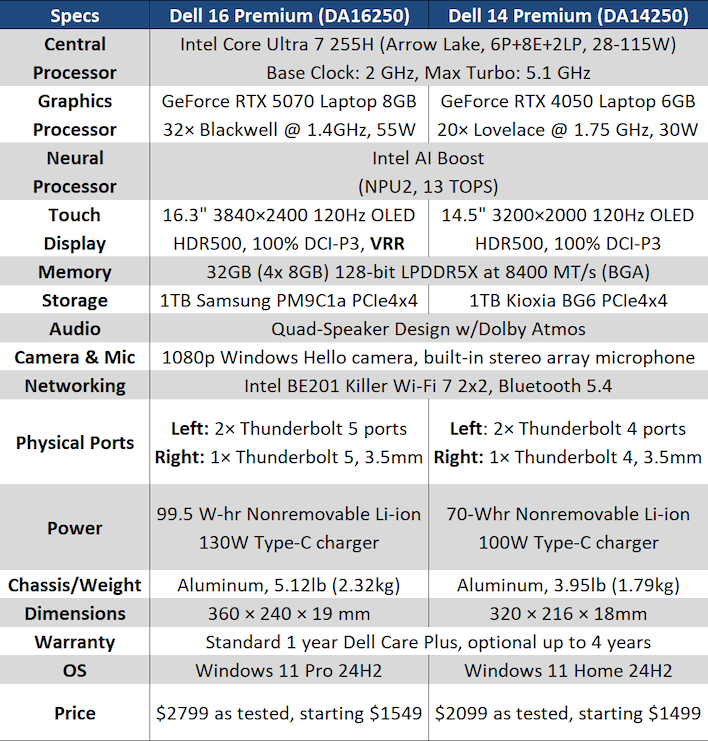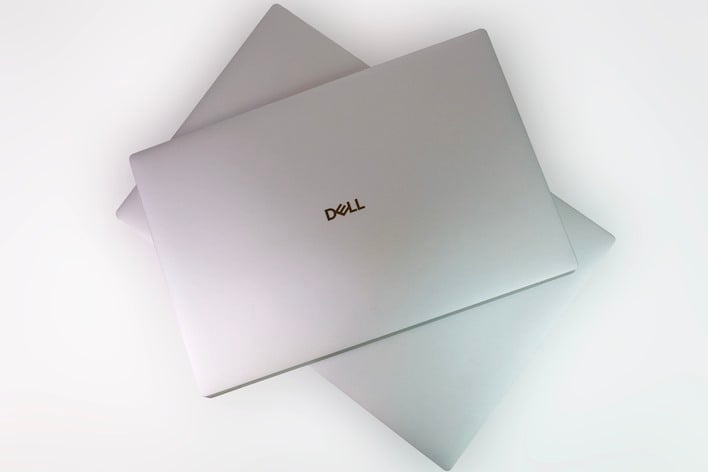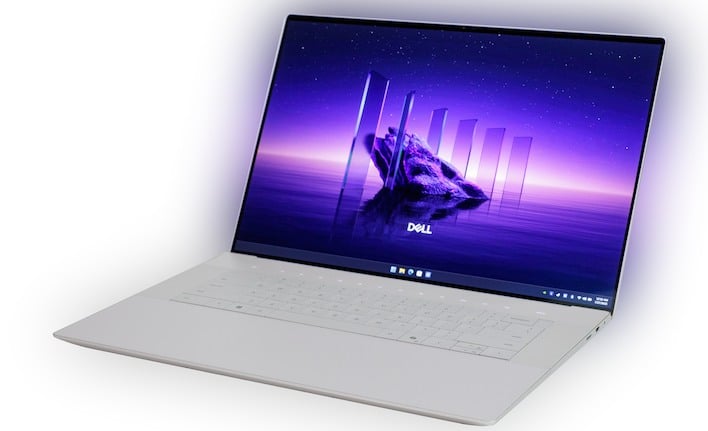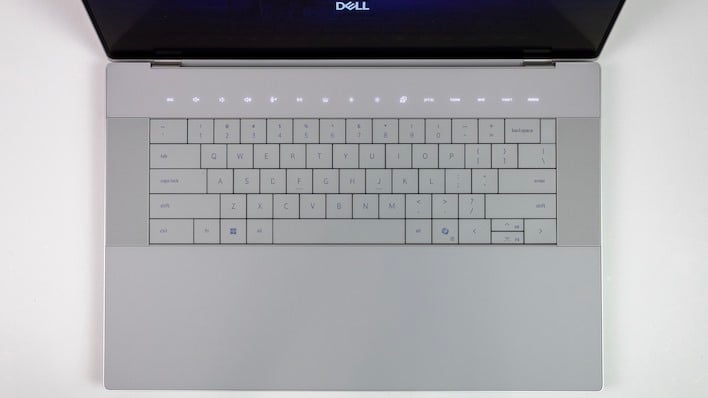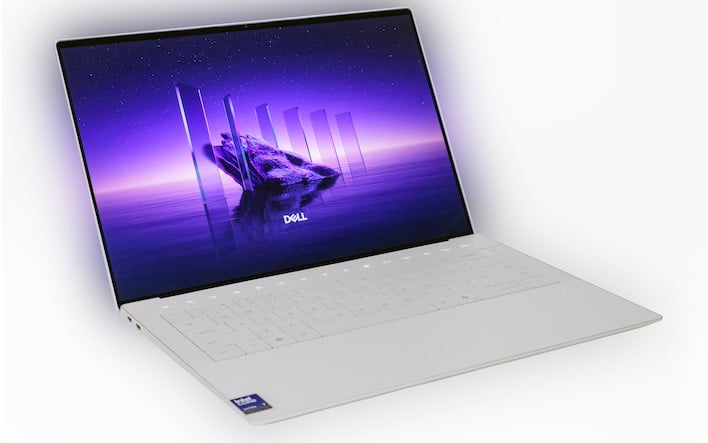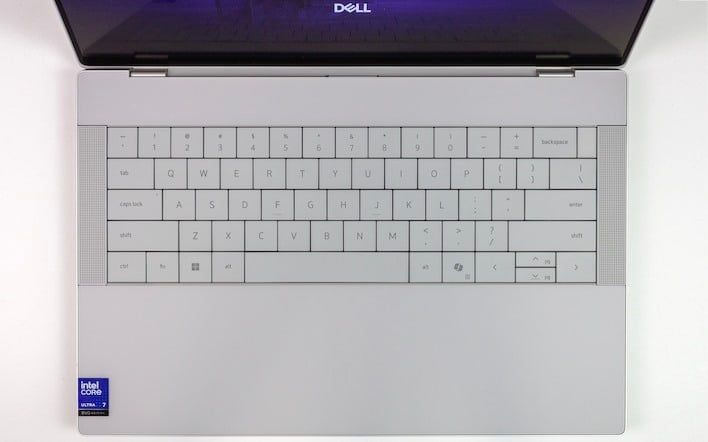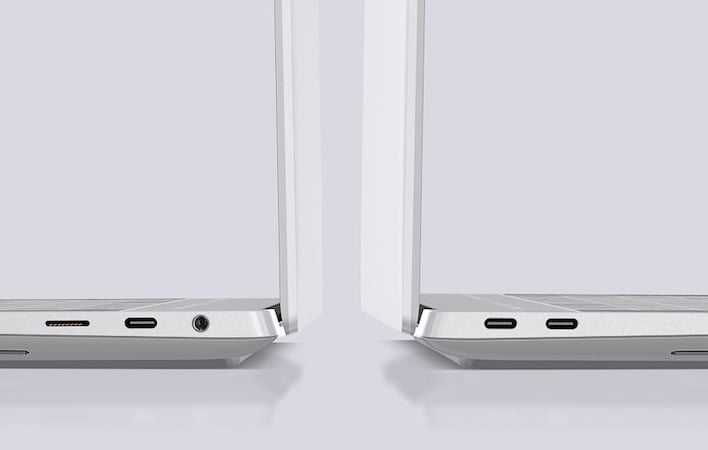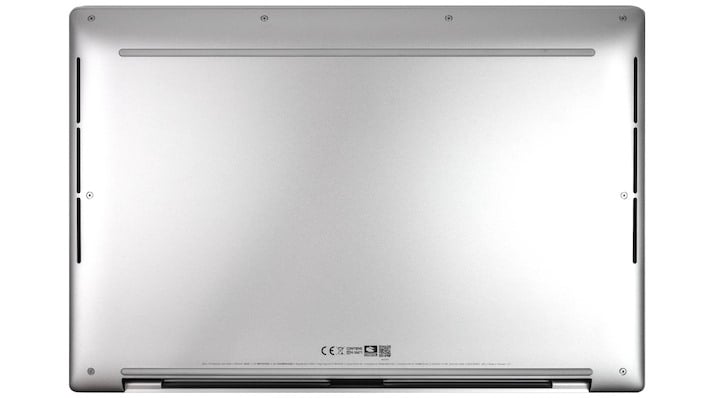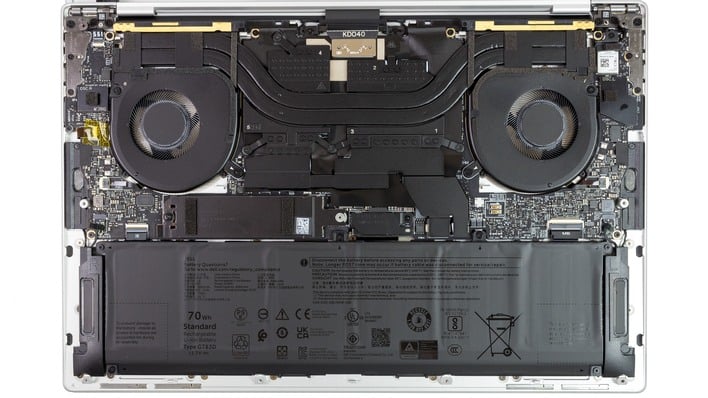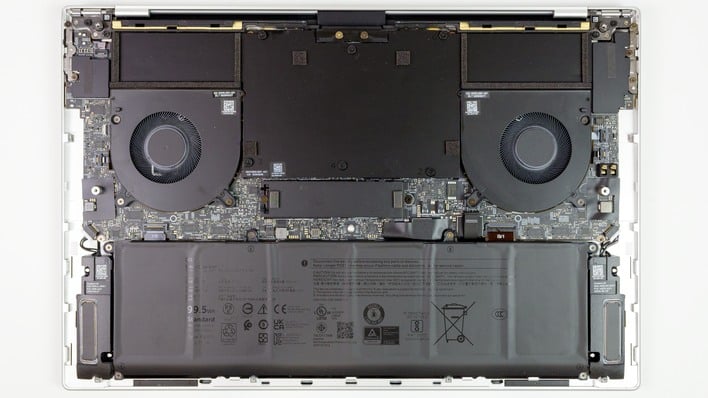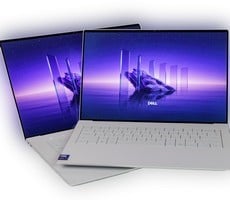Dell 14 And 16 Premium Laptops Reviewed: Supermodels In Every Way
| Dell 14 Premium and 16 Premium Laptops: As tested, $2099 (14") and $2799 (16") Minimalist elegance, stunning displays, and quiet operation are among the top features of Dell's new 14" and 16" Premium laptops, which succeed Dell's venerable XPS family.
|
|||

|

 |
||
The premium thin and light laptop market is a showcase of systems that require high-precision engineering and creative, innovative designs to pack the latest and greatest silicon platforms into extremely tight quarters. The systems also typically make use of higher quality build materials, all of which contribute to premium pricing and typically higher margins, which is exactly what every OEM wants. Such is the case with the new Dell Premium laptops we’ll be showing you here today.
The Dell 14 Premium and Dell 16 Premium are pretty and powerful aluminum-bodied laptops sporting the latest hardware from Intel and NVIDIA, plenty of speedy RAM, gorgeous OLED screens, and ultra sleek, minimalist aesthetics, with price tags to match.
Without further ado, let's check out the specifications on these silver starlets:
While the exterior of these systems is very similar, except for their size and form factor, the interiors differ a fair bit. Sure, both come with the Intel Core Ultra 7 255H CPU, both come with 32GB of hot-clocked LPDDR5X memory, and both come with beautiful OLED screens, but that's about where it ends. The Dell 14 Premium comes with a GeForce RTX 4050 Laptop GPU that's configured with a 30W TGP and no mux. That means it's not switchable; it's configured in hybrid mode. Games can run on the RTX 4050, but they'll output through the Intel graphics to the internal display and as a result it doesn't support variable refresh rate mode.
Meanwhile, the larger Dell 16 Premium comes with a GeForce RTX 5070 laptop GPU that has been slightly kneecapped with a 55W TGP. It still serves pretty well though, as you'll see. It also gets a fancier Samsung SSD that offers more consistent performance than the Kioxia drive in the Dell 14. Beyond that, it gets Thunderbolt 5 support—unique to the RTX 5070 configuration—as well as a larger battery and more powerful speakers.
Fundamentally, though, they're extremely similar machines. They have identical keyboard layouts, and the specifications of their OLED screens are essentially the same aside from the lower resolution on the smaller screen. It has a lower pixel density, too: 260.25 PPI versus 277.81 PPI on the 16.3" model. Both are incredibly sharp, though, and you'd be hard-pressed to complain about either one. We'll gush more about the screens in a second; let's start our walk-around of these systems.
Dell 14 And 16 Premium Design And Features
There is a fine line between 'understated' and 'boring' aesthetics. Fortunately, we think the Dell Premium models fall just on the good side of that line, which is to say that they look pretty elegant in their simplicity. There's very few design features to point out. You get a soft finish on the aluminum chassis, a shiny DELL logo on the lid, and that's about it—there's no RGB LEDs or other visual accents to be found.
Starting with the Dell 16 Premium, we have a very understated thin & light laptop. That's not to say it's not impressive, though. We were immediately struck by how incredibly bright and vibrant the huge OLED screen is on the Dell 16 Premium. It extends nearly to the very edge of the lid, with almost no bezel to speak of, and at peak brightness we measured 505 nits on a small white area of the screen. That's darn bright for an OLED, and it really gives the screen some visual punch in HDR mode.
The keyboard on the Dell 16 Premium is where we come to our first complaint. It's not really about the keyboard itself per se, because the typing sensation is acceptable. No, it's about how the function keys, editing cluster, and ESC key have all been moved to a row of capacitive buttons above the keyboard. This is very stylish and it gives the physical keyboard a shallow, ultra-wide look, but it's also tedious to use. The capacitive buttons do not always register and there's absolutely no feedback, so it's not necessarily clear that you have actually activated the button.
We didn't like the experience, but it's particularly infuriating as a gamer, because so many games require you to hit ESC regularly to back out of menus. Reaching up to hit the ESC key is a reflexive skill for veteran PC gamers, but it requires way more precision than it should on these capacitive buttons. Also, we were glad to see the editing block keys present on the capacitive area, but they go away if you enable the FN lock to access the F-keys.
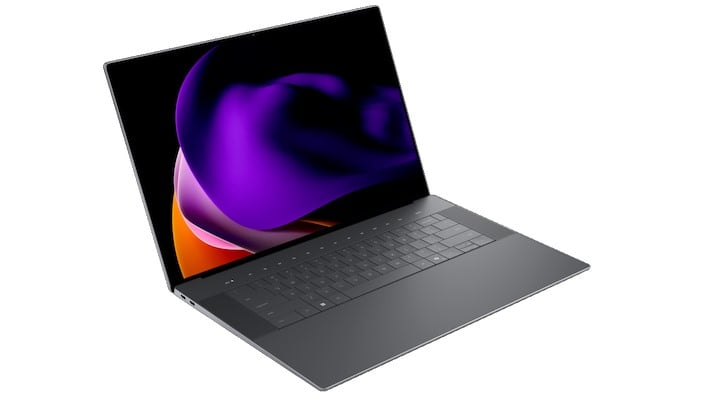
Below the keyboard is an invisible trackpad. Dell describes the wrist-rest of the machine as glass, but it doesn't feel anything like glass. It feels like plastic, frankly. The trackpad is the second of our major complaints about these systems. The responsiveness is simply not very good, particularly for two- and three-finger taps and swipes. They do work, but almost every single "right-click" (with a two-finger tap) required multiple tries to get the gesture to activate.
This probably has something to do with the fact that the touchpad is technically very large. Dell says it extends from the left Windows key all the way to the left arrow key. We will have to take Dell's word for it though, because it is completely invisible and there is absolutely nothing to indicate to you where the trackpad ends or begins or whether your arm is resting on it. It does have a measure of palm/wrist rejection, but we suspect the large size of the trackpad is what was at fault for the poor responsiveness to two- and three-finger taps and swipes.
The Dell 14 Premium is nearly identical to its larger sibling in virtually every single way. That means we have all of the same praises for the screen; it's wonderful, and among the very best displays I have personally tested. The 14" model does lose variable refresh rate compared to the 16" model, but neither of these are dedicated gaming laptops, and the 120-Hz refresh rate divides evenly into 60Hz, 40Hz, or 30Hz, so it's likely you can simply cap your game at an appropriate factor and enjoy perfectly smooth frame delivery even without VRR.
One thing that we want to remark on about these machines is that they have excellent sound. This is more true on the 16" than the 14", but both systems have great audio. On the 14", audio is loud and crisp, with crystal clarity, but it does lack midrange somewhat and bass is lacking. This is honestly to be expected given the tiny size of the drivers. On the 16" model, however, the midrange is nice and punchy even if the bass is still somewhat muted. Both machines set up a nice wide soundstage, with immersive 3D audio thanks to Dolby Atmos. They sound great, simply put.
As you can see, the keyboard layout on the 14" model is identical to that on the 16". Both entirely lack a numeric keypad or anyway to send those key inputs, which is a bit of a bummer, particularly considering that there is no Type-A port with which to connect an external numpad. We'll get to that in a minute, though. By the way, the completely unlabeled button next to the backspace key is the power button. Why it is unlabeled, we won't hazard a guess.
Don't be fooled by the above picture; the 14" model features the same capacitive button row across the top as the 16" and you can see it in the other picture up the page a bit. It's just that the lights for these keys, as well as the white keyboard backlighting, turn off after a short period of inactivity. It does lend the system a very clean look, but we would have liked an option to have the backlight simply stay on. This is really a nitpick, though.
On the topic of nitpicks, let's chat about the I/O on these machines. There's a 3.5mm combo audio jack, and a microSD slot with SD 7.1 (SD Express) support. Besides those, you get three Thunderbolt ports—version 5.0 if you're on the 16" machine with the RTX 5070, and version 4.0 in any other configuration—and that's it. No Type-A ports, no HDMI output, and of course, no Ethernet jack. We could write pages of invective about this decision, but you already know what we would say.
The decision to go with nothing but Thunderbolt was almost assuredly driven by aesthetic considerations, and we do get it. It's just that the complete absence of even a single USB Type-A port means that you need a dongle—which is not included—to use most USB peripherals immediately. A mouse, a USB flash drive, most USB Ethernet adapters, most gamepads, and so on. The world may be moving to USB Type-C for everything, but we simply aren't there yet, and so the decision to go strictly Thunderbolt may be forward looking, but feels contentious.
We'd normally praise the inclusion of a MicroSD Express slot, but this is a laptop aimed squarely at creatives. Professional creatives by and large do not use MicroSD cards. If they use SD at all, they will be full-sized SD Express or UHS-II cards in high-end digital cameras. The inclusion of the MicroSD slot here feels a bit like a checkbox feature; a full-sized SD Express slot would have been downright useful.
Flipping the systems over, you are greeted with this view. The vents on either side are both intakes for the cooling system as well as ports for the quad speaker array. The two strips top and bottom are rubber feet, of course, and they do a great job of keeping the machines from sliding around too much, at least on our wooden table. This is a photo of the underside of the Dell 14 Premium, but the Dell 16 Premium looks completely identical underneath. Ours is a pre-release version that lacks the printing on the Dell 14 Premium, but it should be there in the final version. There's really not much to see though.
Removing the nine tiny Torx-head screws allows you to begin popping the clips around the edge of the aluminum base plate. Getting into the system is not particularly challenging for any experienced laptop technician, but casual users may struggle. Fortunately, there's really not much reason to get into this machine. There's only the one M.2 slot, and the memory is in BGA form, meaning that it's soldered down and not replaceable without some serious soldering iron skills.
Inside the 14 Premium here, you can see the 70-Whr battery that occupies nearly half of the interior of the chassis, as well as the thermal apparatus up top that has surprisingly little thermal mass. The only actual cooling fins in the entire assembly are the tiny grilles at the exhaust vents of the dual centrifugal fans that cool the machine. While there are many more finned grilles on the back of the system, they do not have any direct airflow passing over them and are basically cosmetic.
The inside of the 16" system looks pretty similar to the 14" model, although the M.2 slot gets a more central location and the fans are bigger. Also, most of the cooling apparatus is covered in EMI shielding, so you can't even appreciate its majesty. The 16 Premium's cooling hardware is stated by Dell to be capable of dissipating some 80 watts of heat, while the 14 Premium's cooler is rated for 47W. Both of those specs are below what we would expect given the internal hardware in these systems, which will have an effect on performance, as you'll see on the next page.
Enough gawking and yapping. Let's take these thin and light machines for a test drive...

